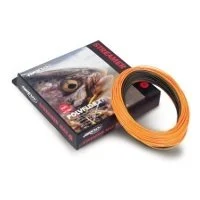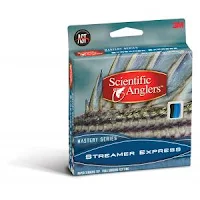 |
| Trout and Streamer |
If you like to streamer fish, it is best to have some sort of sink-tip line with you. Keep one strung up on another rod, or simply load one up on an extra fly spool.
The benefits are huge.
Why? Well, for one, casting is far easier. When fishing tips, we do not need long lengths of leader. Between 3-5 feet of stout mono is adequate. A short leader means that it is easier to turnover furry, sometimes large and weighted streamers. The transition from fly line to fly is much smoother, and less likely to break down on the cast. Heavy flies or flies that don’t cut through the air very well on the end of a long leader/floating line setup can be a pain to cast.Furthermore, these lines are dense; so they add weight, and naturally help to flex or load your fly rod. You can really feel the rod come under load which makes for a lot of stored energy and adequate timing on the forward stroke. On the forward cast, as a result of the added density, the line holds its form and forward momentum extremely well. The result is a nice accurate cast to the target.
They also roll cast better. As stated above, streamers tend not to be very aerodynamic. Furthermore, they are often weighted -so trying to flop these flies over on long leaders is a chore as the leader does not provide enough mass to move the fly off the water. When fishing in tight to shore, being able to roll cast your fly is paramount. Even if you do have the room to overhead, an initial roll cast is a great way to get your line off the water and out in front of you before working into a back cast. Essentially, by eliminating leader length and having more mass close to the fly, we can enjoy less slack and smoother levels of tension into our casting strokes.
Depth. The closer the fly is to a given fish, the more apt it is to get eaten. If you can put that fly into that fish’s space, the angrier that fish is going to get; or the more likely that it will honor its appetite. The less a fish has to travel, the better. Sinking lines get you there, faster. They also help keep your flies looking natural, more even keeled, during the presentation. Also, these lines allow you to keep your patterns at a specific depth in the water column without pulling them up towards the surface and away from a waiting fish. This actually has to do with the overall length of the tip. In fact, full sinking lines are best at maintaining a certain depth throughout the retrieve.
Using sinking lines allows us to throw unweighted flies. We can remove the split shot or the bullet weight, which stay smooth, accurate and operating with far more agility.
Full Sink Versus Sinktip
This is the question. For years I have been fishing a Rio Streamer Tip Type 6. And I like it well enough. The deal with this line, is it has a 15 Foot type 6 tip fused to the floating belly portion of the line. It is smooth casting and I think it’s a fine combination of sink and line maneuverability.My favorite streamer water has nice structure and is somewhere between 2-4 feet deep. For these areas, this fly line works extremely well. However, the fact remains that so many fish are holding deeper and often on the bottom of outside bends, and broad, tanky seams. And this is where I have to add a lot of weight, often a big bullet weight to get into their homes. So you switch and add more weight, which is great for trolling through deeper flows. But, then you come upon a great shallow bank and now you’re stuck with the toil of casting this lumbering wad into an intricate series of eddies and overhanging willows. That is to say, if you don’t remove the weight…
So enter the full-sinking line. They are tapered just like a floating head, however, the entire portion of the fly line (including the running line portion) sinks at various rates. The whole head sinks at the same rate, which is great for getting deep and maintaining that depth throughout the retrieve. And your fly moves naturally through the water column with a high degree of straight-line sensitivity to your fingers. Now the reason I haven’t gone this rout in the past (aside from fishing still water) is the lack of line control once it hits the water. Whether upstream or down, mending is out of the question – because it’s all beneath the surface. So in my opinion, the one knock against these lines is the inability to adjust the direction of the presentation once it has begun. But that said, if you are concentrating fully on your drift – how it will take shape and the direction it should take – before the cast, then this could be a moot point. In fact, Kelly Galloup, possibly the best known streamer angler for trout has been fishing full sink lines for years. And if the photos are real, then he’s been busy hooking many large trout.
Here is a list of the sink tip and full sink lines that we carry. If I have only one rod with me, I tuck my sinking spool right in my fanny pack. Oh, one more note… it’s a good idea to go heavier than you think you should.
Sink Tip Lines
Rio Streamer Tip 15 ft Type 3 (3-4 ips)
Rio Streamer Tip 15 ft Type 6 (6-7 ips)
Rio Streamer Tip DC 24 ft Tip
150 grain – 5-6wts – 4.7 ips
200 grain – 6-7wts – 5.5 ips
250 grain – 7-8wts – 6.4 ips
300 grain – 8-9wts – 7.3 ips

Rio VersiTip II – Comes with four 15 ft interchangeable tips
(Floating, Intermediate, Type 3 and Type 6)
SA Wet Tip (Type 3 – Type 5)
Type 3: 2.5-4.25 ips
Type 4: 3.75-5.25 ips
Type 5: 5.5-6.5 ips
SA Wet Tip Clear - Intermediate (1.5 – 2.0 ips)
SA Wet Tip Express 25ft Sinking Tip
150gr – 4-5wts – 4 ips
250gr – 6-8wts – 5 ips
Airflo Sixth Sense Streamer Max
(Level section of Tungsten Tip fused to intermediate sinking belly section which is fused to floating running line) Customizable: Cut level tip material to desired length for appropriate sink and rod loading.
**This is a cool new approach to streamer lines! Click on the link to see a full description**
Full Sink Lines
Rio Outbound (Intermediate,Type 6 - 38 foot heads fused to intermediate running line)
Rio Outbound Short (Intermediate, Type 6 – 30 foot heads fused to intermediate running line)
Rio Outbound Custom Shooting Taper (35 ft level T-11 or T-14 attached to intermediate running line – cut to desired length).
SA Streamer Express – (30 foot sinking head - fused to intermediate running line)
150 grain – 5-6wts – 5.5 ips
200 grain – 6-7wts – 6.0 ips
250 grain – 7-8wts – 6.6 ips
300 grain – 8-9wts – 7.0 ips
SA Kelly Galloup Streamer Express Long – (50 foot sinking head fused to intermediate running line)
200 grain – 6-7wts – 6.0 ips
250 grain – 7-8wts – 6.6 ips
300 grain – 8-9wts – 7.0 ips
SA Uniform Sink (Tapered 40 foot sinking heads fused to running line of same sink rate) Type 2- Type 5 (1.75 – 6.00 ips)
Please note that I have only included sizes for most trout applications. Also, if you don’t see a particular line listed here, have a look at our full fly line inventory – as I might have let a few slip through the cracks. At any rate, when I think of great streamer lines, these are the ones that come to mind.
Gorge Fly Shop Team





























I Never ever found such edifying blogs. Gone Fishin Lodge
ReplyDeleteI don't fishing frequently but this is a nice share. Thanks
ReplyDeleteBest article on sinking tips ever - thanks.
ReplyDelete